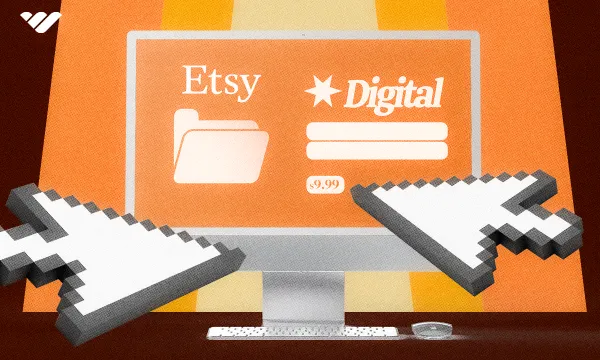When I started selling vintage jewelry on Etsy, the marketplace had yet to open its doors to sellers with digital products. Fast-forward to today, and it’s become one of the most popular places to sell them with thousands of diverse digital products on the platform.
Right now, there’s a real opportunity for content creators, creative professionals, educators, and entrepreneurs to capitalize on the growth of digital product sales, which have surged by almost 70% since 2022.
With expertise and unique skills, anyone can participate and reach a broader audience via sales of digital products. For instance, a fitness trainer could sell workout plans and nutrition guides or a graphic designer could offer customized Canva templates.
You're in the right place if you’re looking for ways to express your creativity and earn well while at it. In this guide, you’ll learn how to sell digital products on Etsy, give you ideas on what to sell, and show you how to get started.
But first, let's look at the reasons why the digital product market is ripe for growth.
Selling Digital Products: Why It's a Good Idea
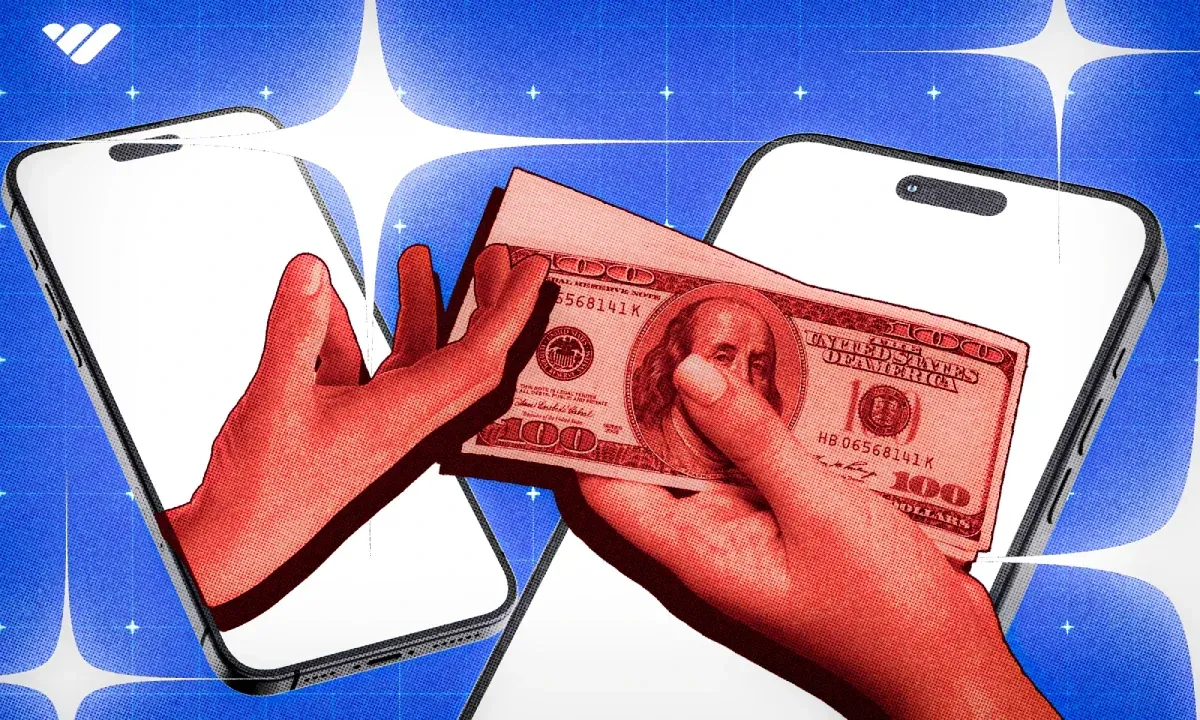
If you're considering starting a digital product business on Etsy, here are some facts to help you make your decision.
Low Barriers to Entry
Starting a digital product business generally requires less capital than one that sells physical products, as the initial investment is primarily devoted to research, design, and/or licensing.
StarterStory estimates the minimum budget for such a venture can be as low as $12, primarily for purchasing a domain name (but if you're signing up on a marketplace such as Etsy, you won’t need it.)
Low Operational Costs
Digital products are available for download, and don’t run out or expire. Therefore, demand fulfillment and manufacturing aren't resource-intensive.
Automated tools also allow for more efficient handling of sales and product updates, reducing manual tasks. For instance, Etsy’s platform automatically sends customers email updates about the delivery of their digital product orders.
Large Market Reach
According to Statista, digital commerce will reach 5.5 billion users by 2027. Digital product sellers can profit from this growing sector without worrying about geographic limitations.
For example, since they can be downloaded anywhere, a US-based bakery can sell ebooks and courses on baking to anyone in the world—not just to the local crowd.
High Profit Margins
Digital products command high profit margins due to low production and distribution fees. This one-and-done production requires minimal ongoing maintenance, like occasional information updates. Once created, each sale counts as instant revenue.
Effortless Scalability
The system for digital products remains the same no matter how many units you sell. So instead of worrying about mass production, digital product creators can focus on diversifying their offerings. Etsy Seller Digital Curio carries a range of digital products, such as journal papers, clip art, and graphic bundles.
Timely Fulfillment and Feedback
With digital goods, buyers receive the product instantly. Upon receipt, digital product owners using platforms, such as Etsy, have easy access to customer feedback and communication.
By knowing what their customers look for, digital creators can easily tweak content, release new versions, or create complementary products to meet those needs.
11 Digital Downloads You Can Start Selling On Etsy
Based on your expertise, you can create a wide range of digital products. Here are ideas, tips, and real-life examples of how to sell the best digital downloads on Etsy.
1. Canva Templates
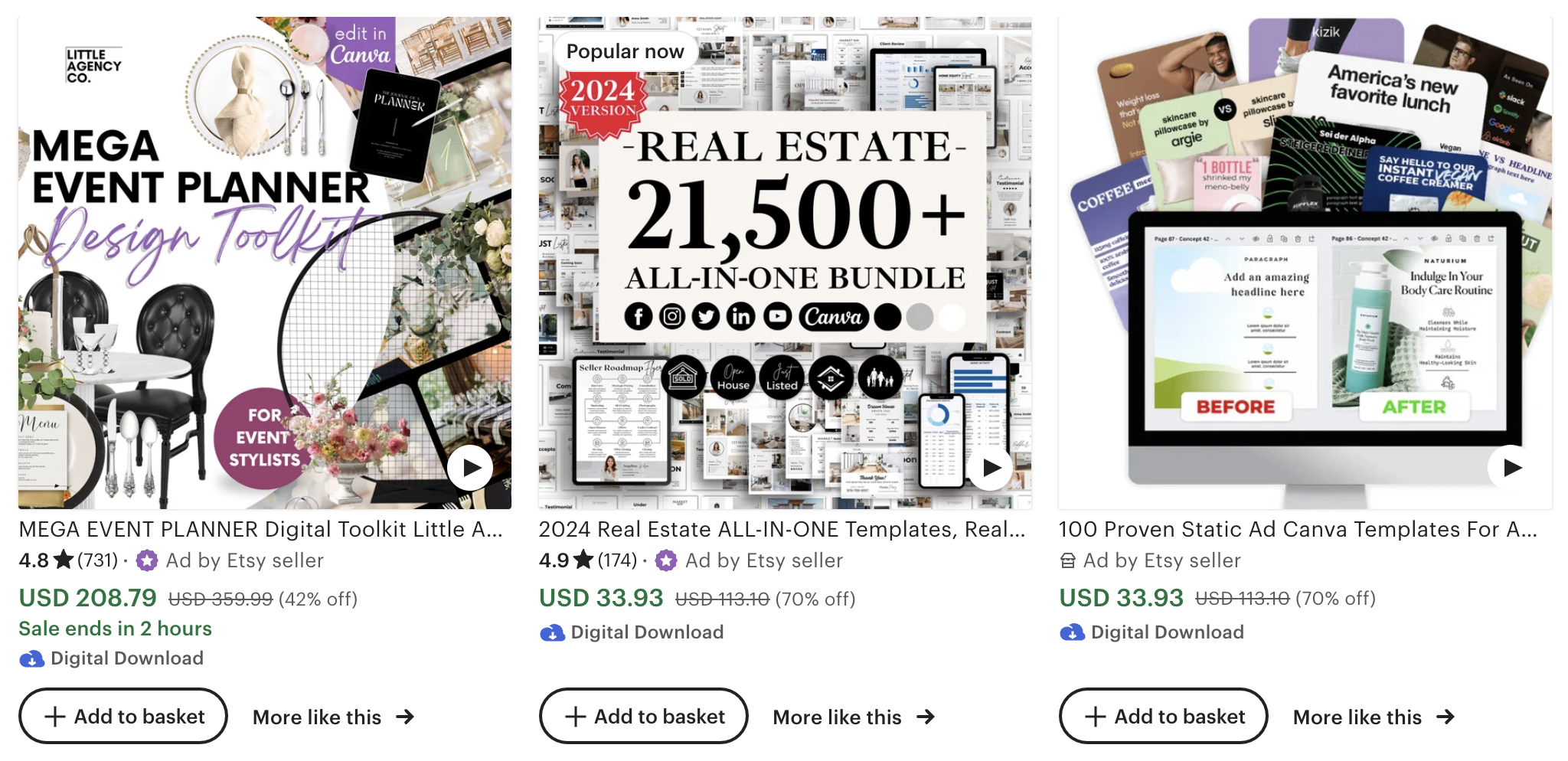
Canva is a graphic design tool with a community of over 170 million users. Many of them are seeking design elements and templates for their projects.
If you’re wondering how to create digital products on Canva to sell on Etsy, try to be original. For Canva, this means combining various Canva Content design elements using different editing techniques.
You can’t use Canva Free and Pro content if you’re creating stock graphics, such as clip art.
But you can use them to design and market products, such as:
- Ebook pages
- Presentation or slide decks
- Checklists or worksheets
- Planners and calendars
- Brand and media kits
One caveat: Template designs can only leverage Pro Content if you share your design as a Canva template link.
Here’s an example from PremiumdigiCo featuring different types of planners, journals and trackers. Shoppers receive a PDF containing a link to the editable Canva templates:
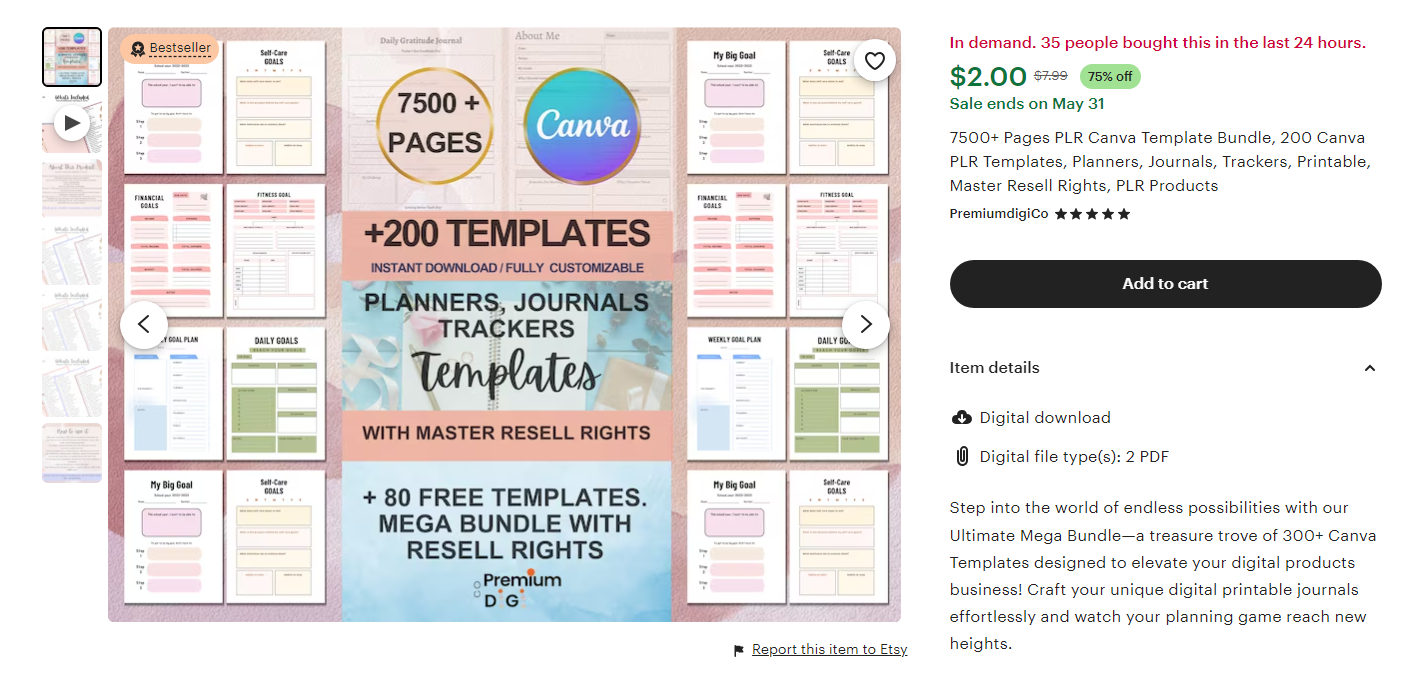
2. Printable Art
The digital artwork market is booming, anticipated to hit $12.1 billion by 2030. People want to get their hands on personalized artwork, digital art prints, inspirational quotes, and watercolor or oil painting illustrations.
Artists can capitalize on this trend by offering unique and high-quality digital art, such as this Wildflowers oil painting by MitArtPrints:
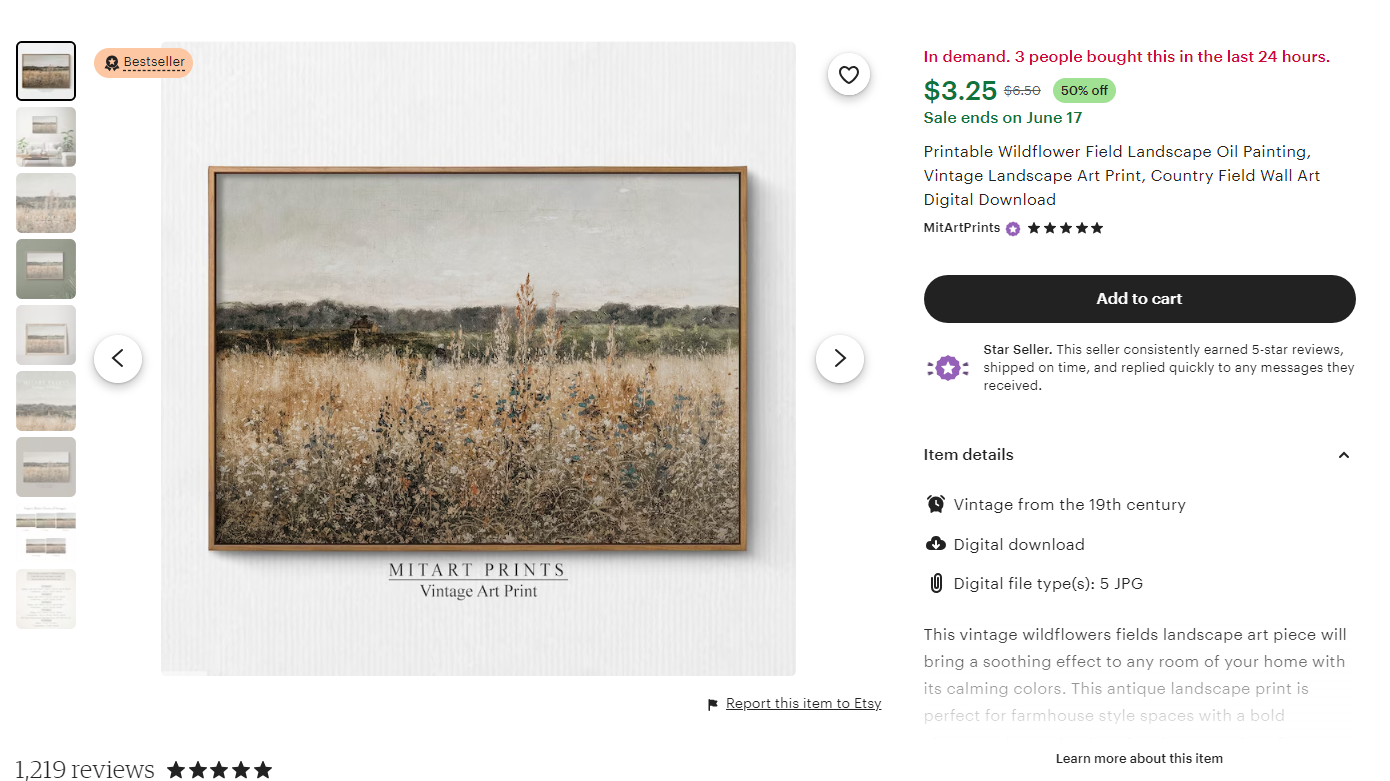
The painting is available for instant download and comes with cracks, worn textures, and grain defects for effect. It’s ideal for Etsy shoppers seeking a vintage piece at a reasonable price.
3. Digital Planners and Calendars
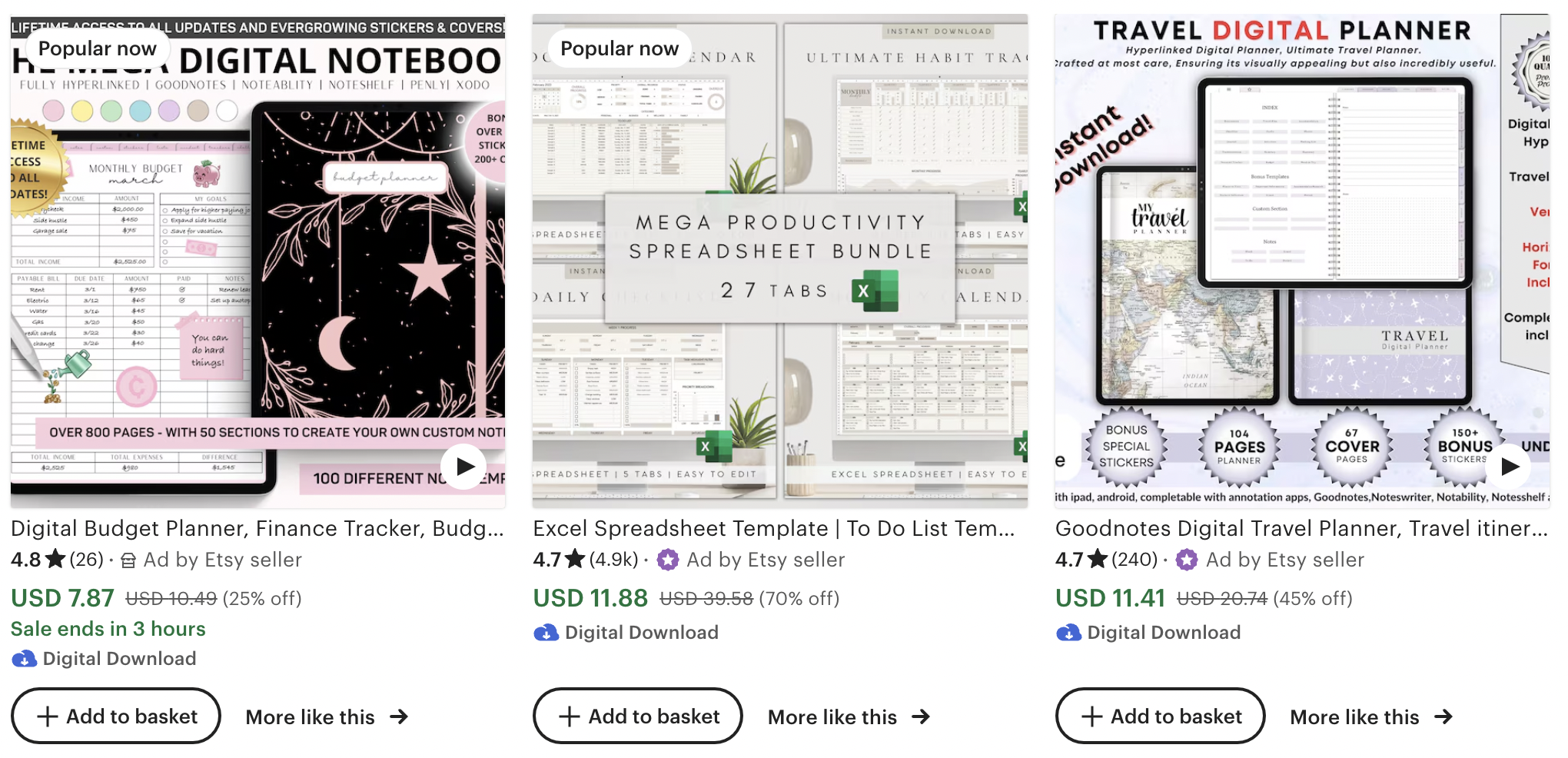
During the pandemic, Etsy seller Kayla Warner reported making $93k in revenue from selling digital planners. This isn’t surprising since the global diary and planner market is expected to reach $1,722.98 million by 2031.
Within this category, here are some products you can sell on Etsy:
- Daily, weekly, and monthly planner and calendars
- Goal trackers
- Habit trackers
- Meal planners
- Notion templates
These products can be electronic (for iPads and laptops) printable, and pre-formatted or customizable.
The Planners Collective put out a custom digital bundle that has since received 3,000+ reviews:
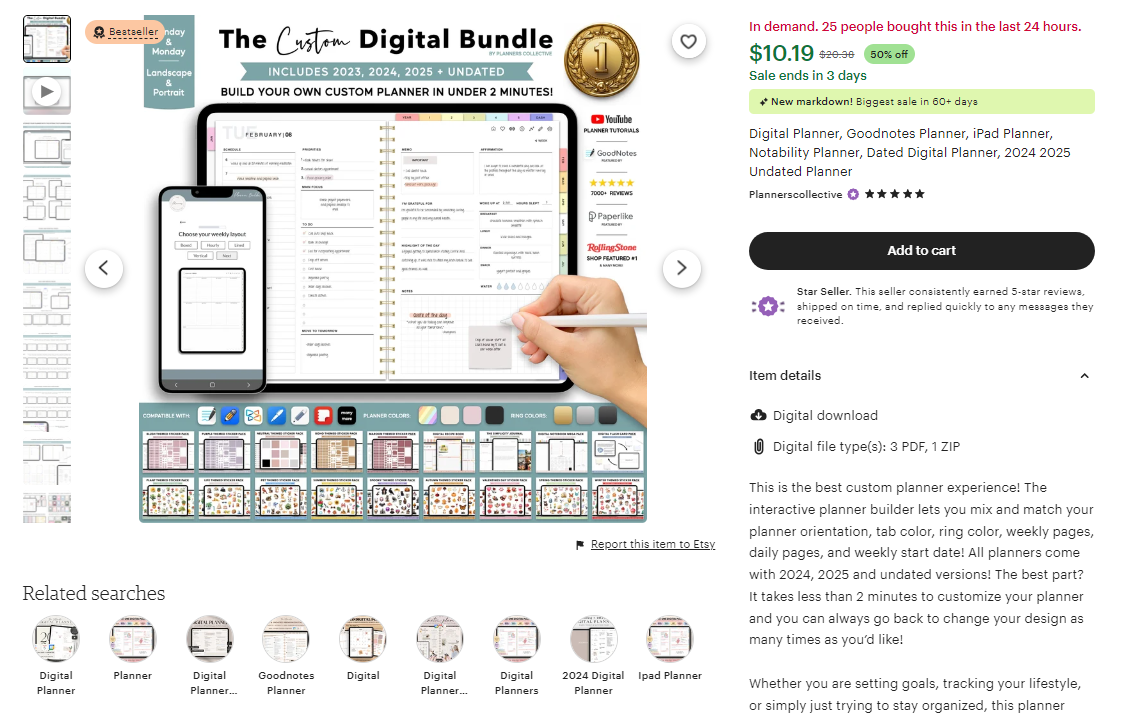
4. Ebooks, Guides, Courses, and Workbooks
If you have a special skill or expertise, you can share it with like-minded individuals by selling a digital product on Etsy (such as an ebook, course, or workbook.)
The sky’s the limit for topic ideas. The most common offerings on the platform are about self-help, recipes/diet, fitness, photography, and marketing. But it doesn’t mean you have to settle for one of these categories.
Many sellers succeed in sharing specialized knowledge, such as Scrub Studies, an Etsy Shop that has generated 18,100+ sales while focusing on creating downloadable nursing study guides.
Here’s an example of its products:
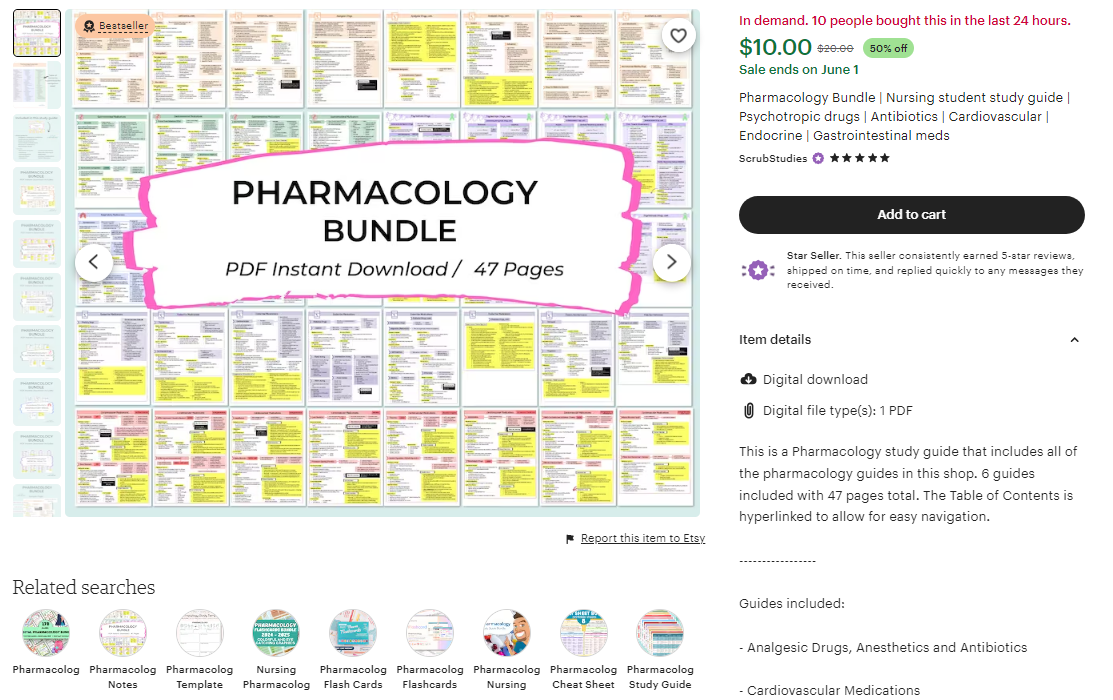
5. Graphic Design Resources
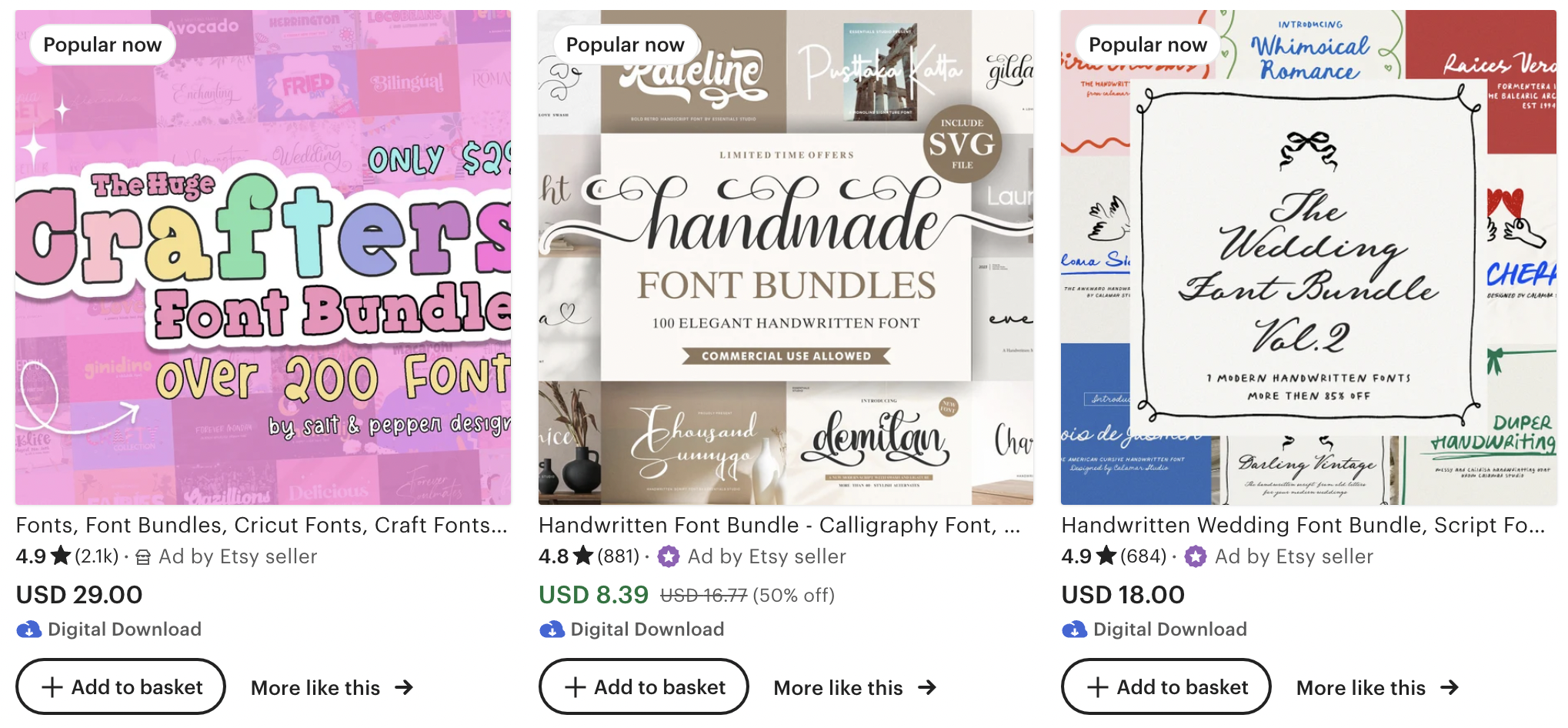
Graphic designers and artists can earn passive income by creating design elements, such as fonts, clip art, patterns, textures, and more.
Content creators, brands, and fellow graphic designers can take advantage of these valuable assets for their work. For example, the Handwritten Font Bundle by EssentialsStudioID offers a variety of fonts designed to make any project look unique.
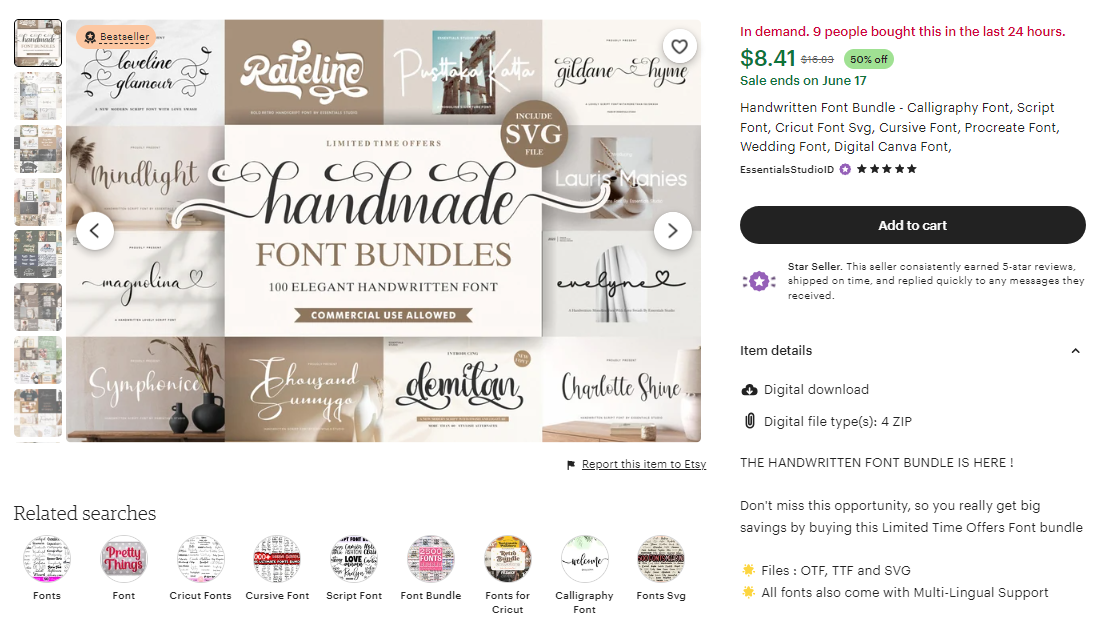
The downloadable fonts work on Canva, Adobe Illustrator/Photoshop/Indesign, Cricut Design Space, Procreate, Word, Corel Draw, Inkscape, and more.
6. Stock Photos and Photography Presets
Bloggers, business owners, marketers, and content creators always look for high-quality images to enrich their websites and social media posts. Photographers can take advantage of this need by creating stock photos for various industries, such as fashion, nature, and travel.
Apart from this, they can also sell preset bundles to fellow and aspiring photographers, which speed up the photo editing process. Products like the Lightroom Preset Bundle by AYxStudios offer a consistent and professional look to photos; even beginners can use them.
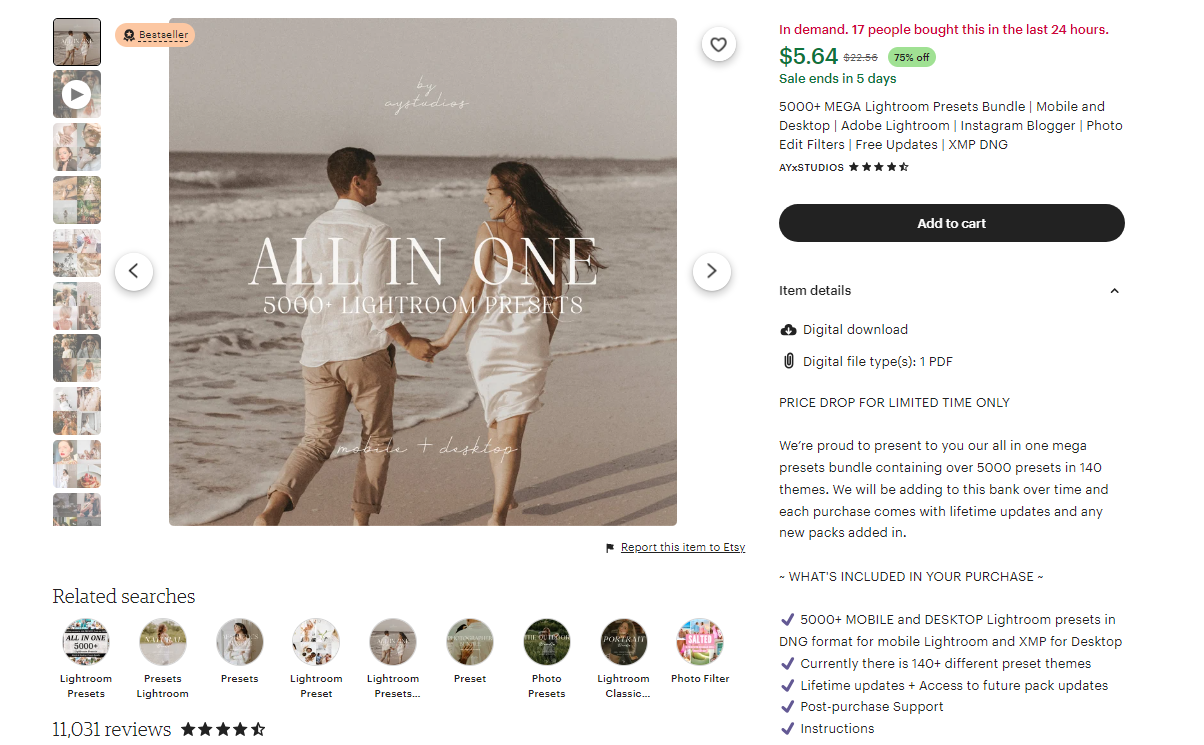
7. Audio and Sound Effects
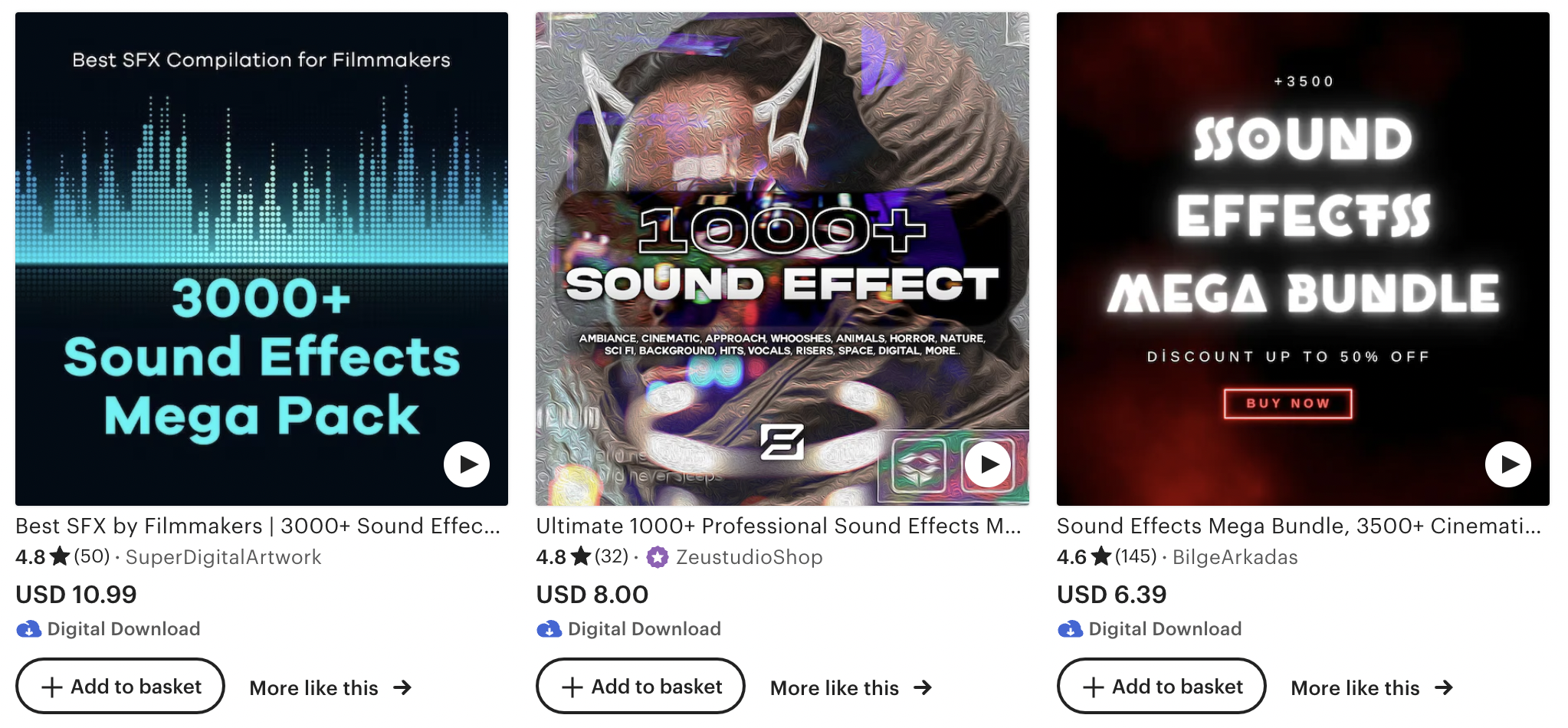
Musicians and sound designers can profit from the digital products market by selling audio tracks, sounds effects, jingles, and audio logos. Like photos and graphic design assets, these are highly in demand in the content creator economy–the sound effects industry has a CAGR of 10.3%.
Vloggers, video producers, and podcasters are always on the lookout for versatile sounds to add to their work. Here’s an example from OldSkoolMusicMan:
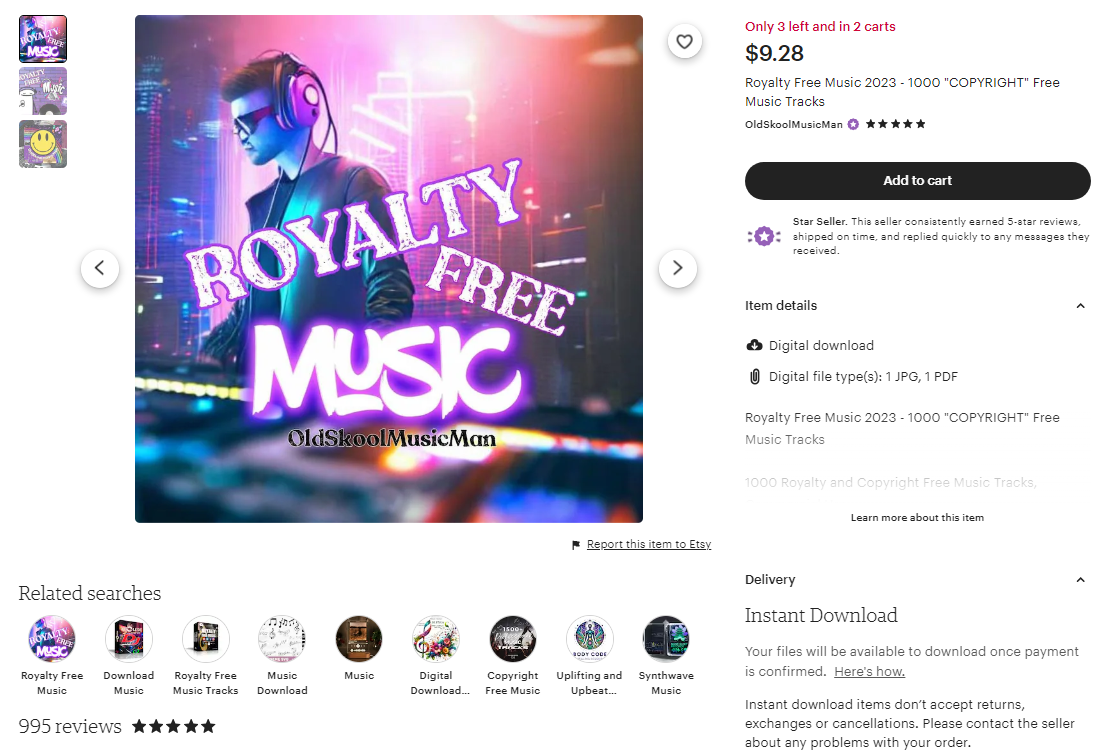
According to the seller, the tracks are copyright-free for personal and commercial use.
8. Printable Educational Materials
Educators, homeschoolers, and parents can make use of educational printables, such as worksheets, lesson plans, and flashcards to enhance their lessons.
Moreover, it is a lucrative industry. A former teacher, Lisa Frank, reported making $400,000 per year selling educational printables. While she’s not earning this much exclusively from Etsy, it’s on the platform that she found her footing.
Here’s one of her products from her shop Think Tank Escape Rooms:
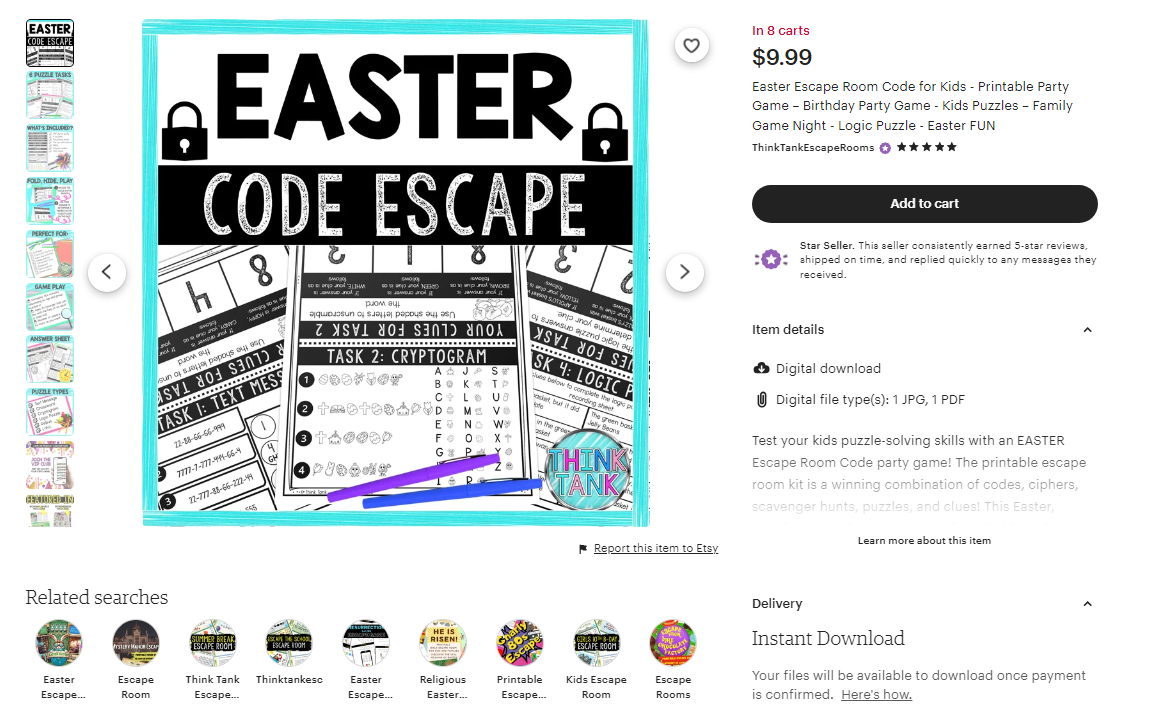
9. Printable Event Invitations
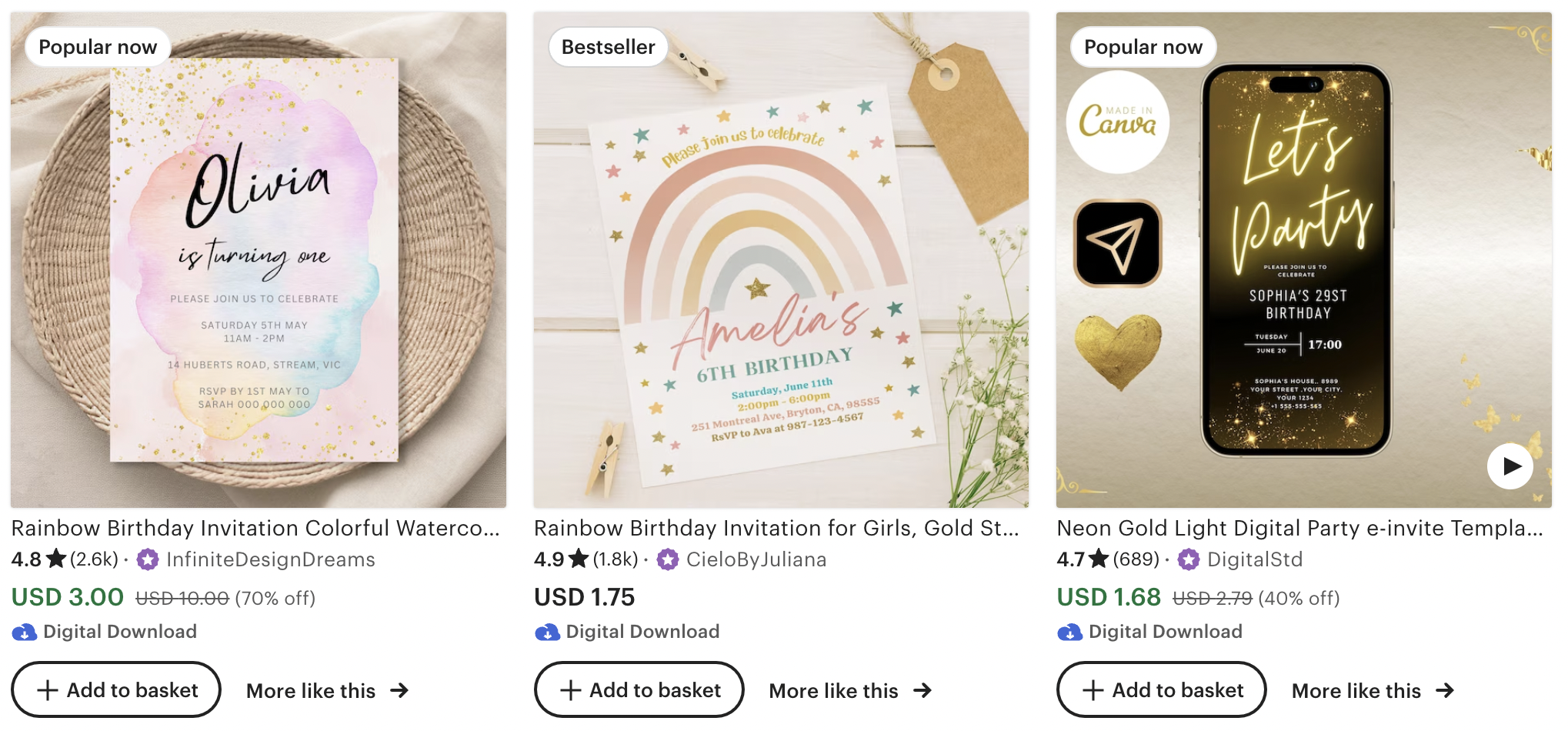
Wedding, birthday, graduation, and business party invitations are popular products that offer convenience and customization. You can expand on these by including additional items such as seating charts, thank you cards, favor tags, menus, and banners.
The Graduation Party Set by Redlinecs contains everything you’d need for a milestone celebration:
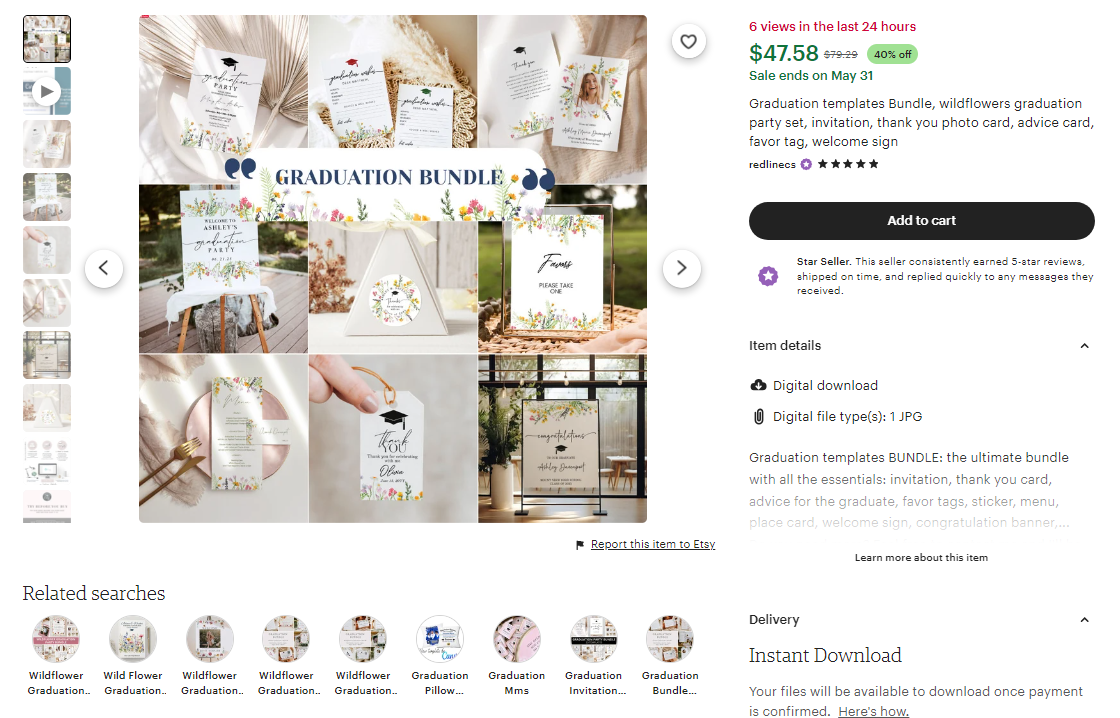
10. Etsy Shop Assets
Is there a better place to sell Etsy shop assets than…Etsy? With these, you can help fellow Etsy sellers improve their shops' appearances and performance with banners, listing templates, and customized order receipt templates.
From there, you can create a bundle, such as this Etsy Shop Banner Kit by SunshineStudioBtique that sellers can use as a springboard:
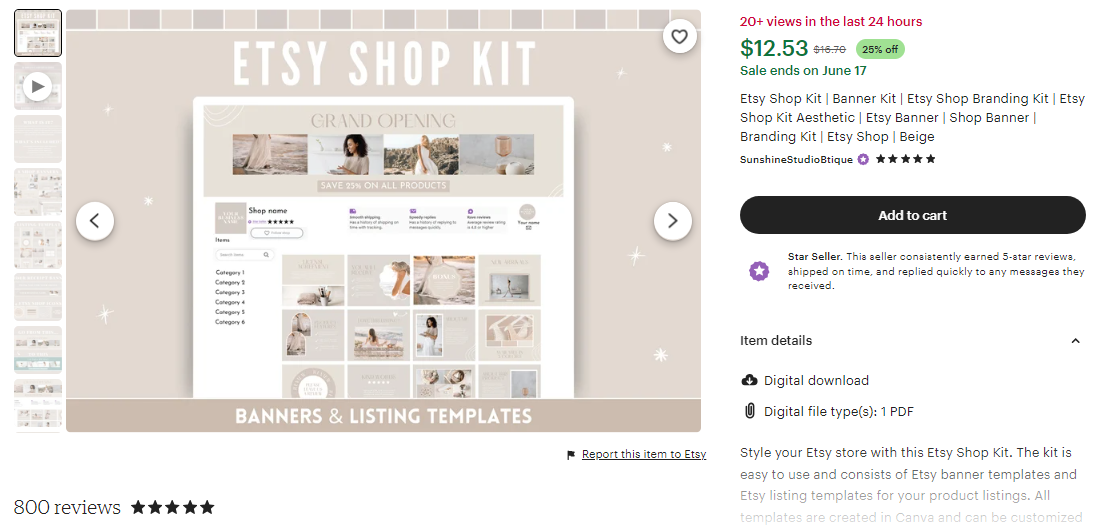
In Canva's free version, users can customize all templates, such as changing texts, colors, fonts, graphics, and sizes. One shopper left a review, noting, “This helped me save so much time updating my own Etsy shop. Thank you!”
11. Website Themes
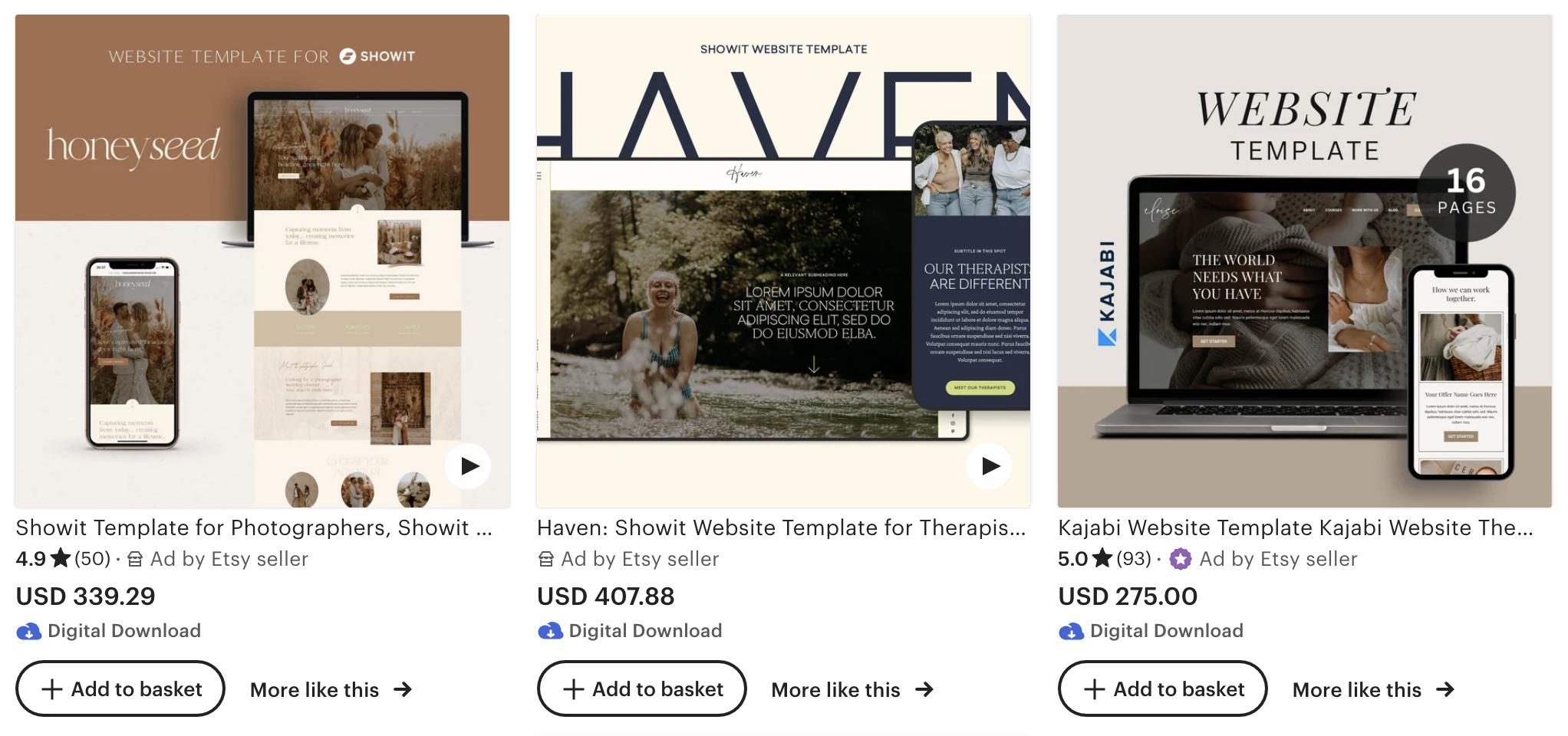
Creating website themes for platforms like WordPress, Shopify, and Squarespace can be a profitable opportunity for web designers who want to sell digital products on Etsy.
For instance: Squarespace templates alone are estimated to yield 8,000 searches per month on the platform. Here’s an example of one by Thirty One Palms Studio:
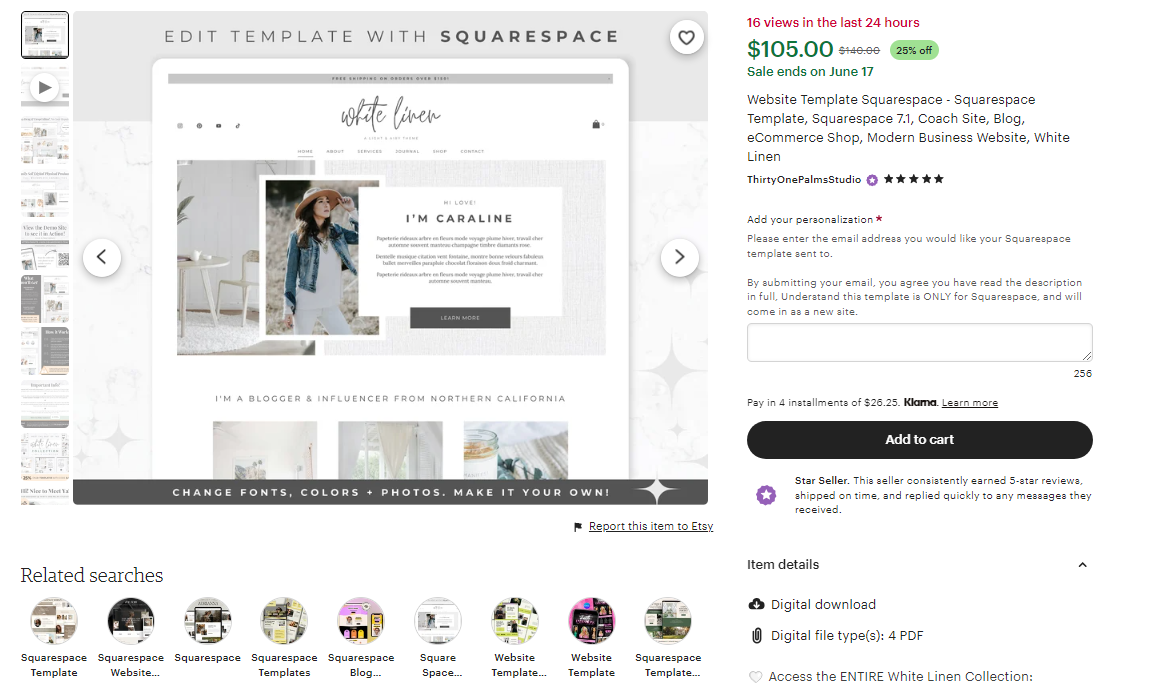
The theme is stylish, functional, and customizable to meet the needs of modern entrepreneurs who aren’t tech-savvy. This is why website themes are in demand; they help beginners and DIY-ers easily build professional and well-designed websites.
Sell Digital Products on Etsy in 5 Easy Steps
Now that you have a product in mind, follow these steps to launch your digital product business on Etsy.
Decide on a Niche
Narrow down your niche by combining your preferences with Etsy keyword research. Type a generic term for your niche in the Etsy search bar (like: online courses), and see what niches emerge.
There are also free tools, such as Alura, to conduct research and study Etsy SEO. Such tools can help you perform a deep dive into specific Etsy shops and learn how profitable their business is.
Competition is fierce, so the more specific the niche, the better. According to a Reddit user, “You’re going to have a much higher chance if your digital downloads have some sort of skill moat, for instance selling custom 3D models, crochet patterns, things that can't be replicated by Canva/AI image generators.”
Look at what you enjoy and identify a problem you wish to solve. Chrissi Burrell has put this idea into action, earning nearly six figures from digital downloads on Etsy. Chrissi says:
“Underserved niches combined with excellence in customer service, in my years of experience of selling on Etsy, is a winning combination for success and great income,”.
Aside from having a digital product that serves a gap in the market, she also encourages sellers to offer some form of personalization that can make their digital products stand out. This appears to be true: One of Etsy’s star sellers is Memorialize Shop, a shop that allows shoppers to customize paintings of family portraits and download them digitally.
Define Your Audience
Determining your target market is another way to ensure you create well-selling digital products on Etsy.
Jordi Rodriguez, an Etsy seller making $50,000 per year selling digital content, suggested doing this to complement your niche deep-dive:
“You'll get to know your customers better and offer the products they need. This approach won't limit you to just one single niche, which is the most common error new Etsy sellers make when they start.”
Currently, he owns two successful businesses on the platform.
If you have found a niche, you can identify your audience quickly by checking out who’s purchasing from your competitors. Read reviews about them and their products to discover what drives or repels their buyers.
You can also learn more about an Etsy shopper by clicking on his or her name. This allows you to explore the shopper’s favorite items and shops, as well as the personal categories they’ve created.
Create Your Digital Product
If you’re wondering how to make digital products to sell on Etsy, there are two options: Hire a professional or do it yourself.
When hiring a professional, use trusted platforms such as Upwork, Fiver, Behance, or Freelancer.com. It’s more expensive than creating the product yourself, but saves time, effort, and ensures high-quality results.
If you opt to DIY it, tools such as Canva, Notion, and Adobe play an important role in creating digital products to sell on Etsy.
- Canva offers a huge collection of graphics, which you can edit in great detail. It has a freemium and Pro version.
- Photoshop and Adobe Creative Cloud are indispensable tools many professionals use, but can be more challenging and expensive for beginners. However, Adobe products allow for more customization, ensuring your digital products are unique.
- Notion is great for selling templates or text-based digital products. Like Canva, it comes with both a free and paid version.
Sign Up and Set Up Your Online Store
You can sign up directly on Etsy.com/sell or download the Etsy app. To become an Etsy seller, you’ll need a merchant account.
Select "Open a Shop" and follow the necessary steps, including specifying your language, country, and currency and deciding whether you'll be selling full-time or part-time. Modifications can be made later if necessary.
Next, you’ll have to name your Etsy store. Etsy suggests using descriptive or abstract names. Don’t forget to capitalize each word to improve readability.
Last, you’ll need to set up your payment and billing options. Note that once you've opened your store, you'll be charged $15 for shop set-up.
Remember to customize your storefront with your logo, banners, shop announcements, and more. With your shop ready, the only thing left is to put your products on display, which brings us to the last step.
Publish Your Digital Products
Digital downloads are listed similarly to physical products on Etsy. But the key difference is that you need to choose whether your product is an "Instant Download" or "Made to Order."
Instant downloads allow customers to immediately access audio, image, or text files upon purchase, while made-to-order products are customizable. In this case, buyers will receive a confirmation email after purchasing, and you’ll need to upload the completed digital file once customization is finished.
Other aspects to think about before you hit publish are:
- Product photos: Etsy Seller Sarah Levinger that it pays to be unique because people scroll through thousands of photos before choosing a product. She says, “If you can identify what everyone else is doing, it’s easier to stand out by doing something different.” Be sure your listings are packed with eye-catching graphics and close-up pictures to attract and convince buyers.
- Copy or Product Description: Amanda von Ingenbosch, another Etsy shop owner, believes writing clear and concise copy is key to convincing the target market that it’s your product they need. Levinger agrees and recommends using testimonials to help people understand the value of your goods. She adds, “Use testimonials BEFORE your descriptions. Social proof goes a long way.”
- Social media: Etsy is competitive for sellers. One key phrase leads to thousands of results. Using ads puts you at the top of the list, but it’s not as sustainable as using social media to drive traffic to your Etsy shop. Von Ingenbosch uses Pinterest and Facebook to bring in customers to her shop, “I utilize a lot of tools and integrations for marketing my shop on Etsy externally.” Personally, I did it myself when I was selling on Etsy. I marketed my products through my Tumblr blog and social media, as well as partnering with fashion bloggers for product seeding and giveaways.
By focusing on these factors, you'll be able to better showcase your digital products and attract potential buyers.
Is Selling Digital Downloads on Etsy Worth It?
Selling digital products on Etsy can be worthwhile, but it may not be the optimal platform.
While Etsy provides a well-established marketplace and a large customer base, competition there is fierce. One seller laments,
“It feels like I constantly need to reinvent myself to stay ahead, but even then, other shops seem to quickly catch on and copy my ideas. I've already maximized my ad spend to a thousand a day, but I'm still struggling to keep up.”
Furthermore, Etsy’s features are primarily tailored for handmade and vintage goods rather than digital products. I know from experience that its product management capabilities for digital products are limited compared to platforms like Whop, which specialize in them.
Whop offers several advantages for digital product sellers, such as an extensive digital product management platform for effectively handling and marketing digital downloads. It also charges a significantly lower transaction fee of 3%, compared to Etsy’s 6.5%. Moreover, it’s more scalable, allowing for features like membership programs, which Etsy doesn’t support.
Why Whop is the Best Platform for Selling Digital Products
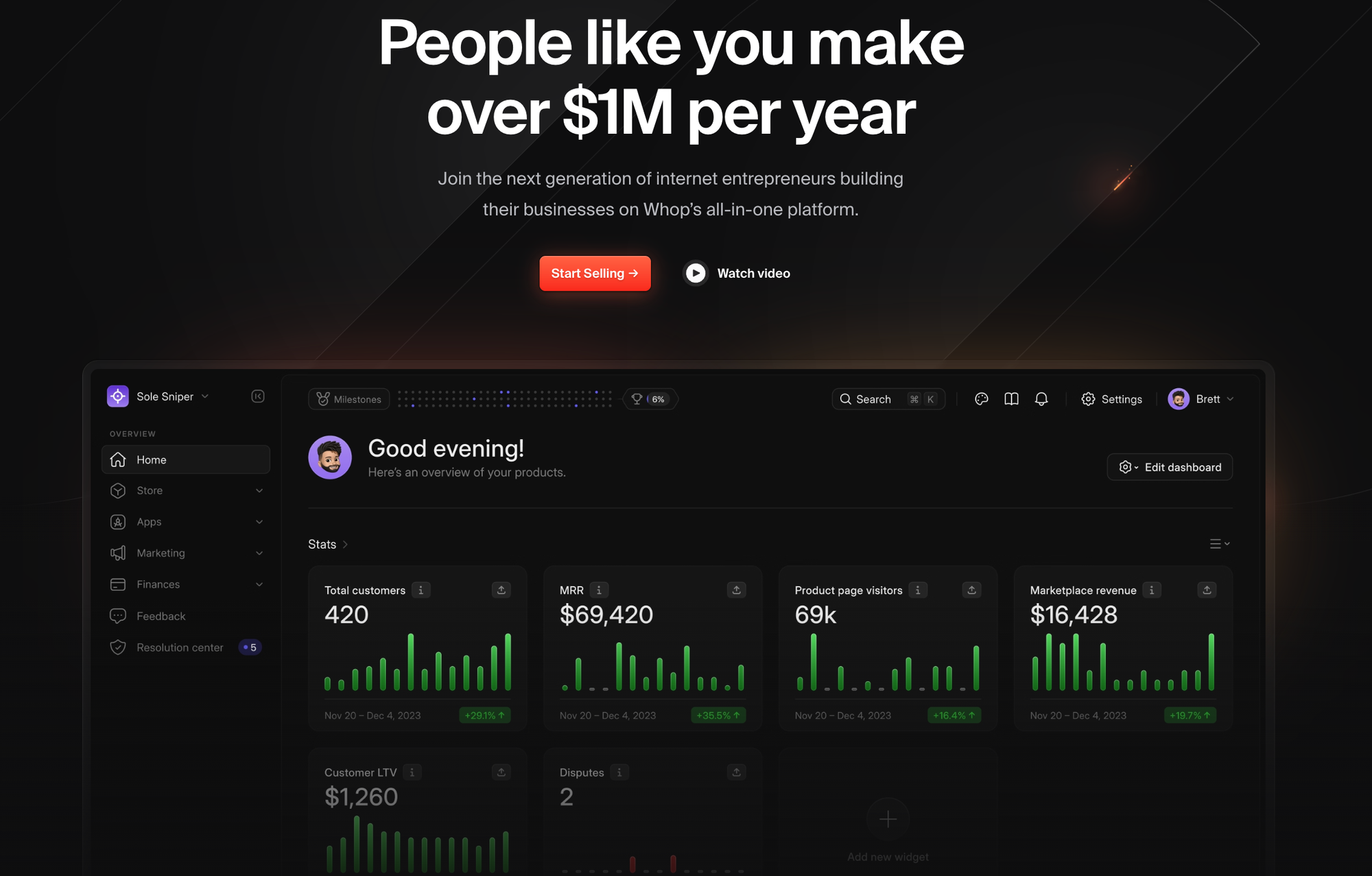
Etsy may be a good place to start selling digital products because of its visibility and established user base, but platforms such as Whop offer more specialized tools, lower fees, and a less crowded market, which make them better suited for individuals and companies seeking to scale their digital product business.
Plus, with Whop, you can create everything from courses to communities, to digital downloads, software, ebooks, templates, and so much more. You can sell all of these from your own Whop Hub, bundle items together, and create a thriving community around your products with a suite of marketing tools. All of this for only a 3% fee!
Whop has sold over $350,000,000 in digital products - and it's just getting started.
Etsy Digital Products FAQs
Do you need a license to sell digital products on Etsy?
Etsy's seller policies don’t require business licenses for selling on their platform, making it accessible for hobbyists and small-scale creators alike. However, Etsy requires that sellers adhere to its infringement policy to ensure they’re not violating intellectual property rights.
More information on these policies can be found on Etsy's IP Policy.
How much does Etsy take per digital sale?
Etsy.com charges a transaction fee of 6.5% for every sale you make. This doesn’t include the VAT that the platform will have to collect from buyers in certain countries and pay to the corresponding tax authorities.
More details on fees can be found on Etsy's Fee Policy.
What are the best digital products to sell on Etsy?
Some of the most popular digital products to sell on Etsy include digital planners, Canva templates, and printable art. For a comprehensive list of profitable digital product ideas, we’ve outlined 11 of them above.
Do I need to copyright any digital products I sell on Etsy?
In the US, copyright protection is automatically granted to works that qualify for one. However, opting to register your works will grant you a certificate of registration and a public record of the copyright, which can be beneficial in the event of a dispute.
More copyright information can be found in Etsy's copyright help article.
